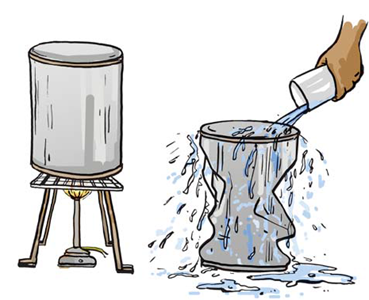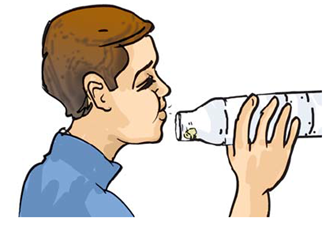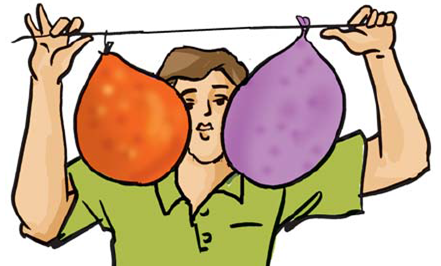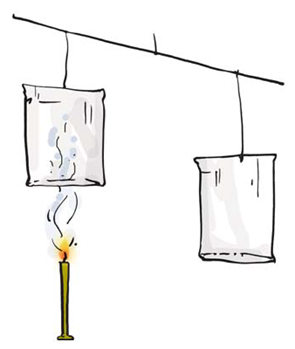Extra Questions for Class 7 Science Chapter 8 Winds, Storms and Cyclones
Extra questions for Class 7 Science Chapter 8 Winds, Storms and Cyclones with answers is given below. Our subject expert prepared these solutions as per the latest NCERT textbook. These questions will be helpful to revise the all topics and concepts. CBSE Class 7 extra questions are the most simple and conceptual questions that are prepared by subject experts for the students to study well for the final exams. By solving these extra questions, students can be very efficient in their exam preparations.
Winds, Storms and Cyclones Class 7 Science Extra Questions and Answers
Very Short Extra Questions and Answer
1. What are monsoon winds?
Answer: The winds from the oceans carry water and bring rain. These winds are called monsoon winds.
2. What is natural disaster?
Answer: Natural disaster are extreme, sudden events caused by environmental factors that injure people and damage property.
3. What is wind?
Answer: The moving air is called wind.
4. What is anemometer?
Answer: The instrument that measures the wind speed is called an anemometer.
5. When you fly a kite, does the wind coming from your back help?
Answer: Yes, the force of the wind pushes the kite upwards and backwards.
6. Does the water give back heat when vapour condenses into liquid?
Answer: Yes, the water gives back heat when vapour condenses into liquid.
7. What is the main cause of wind movement?
Answer: Uneven heating on the earth is the main cause of wind movements.
8. Why we fill air into the bicycle tube?
Answer: We have to fill air into the bicycle tube to keep it tight.
9. Where do thunderstorms usually develop?
Answer: Thunderstorms develop in hot, humid tropical areas like India very frequently.
10. What do tornadoes look like?
Answer: Tornadoes can appear as a traditional funnel shape, or in a slender rope-like form.
11. From where does the word monsoon derived? What does it mean?
Answer: The word monsoon is derived from the Arabic word ‘mausam’, which means ‘season’.
12. What is the direction wind in winter?
Answer: In winter, the direction of the wind flow gets reversed; it flows from the land to the ocean.
13. What are the factors that contribute to the development of cyclones?
Answer: Factors like wind speed, wind direction, temperature and humidity contribute to the development of cyclones.
14. What role does the wind play in the formation of storm?
Answer: All storms are low pressure systems. Thus, wind speed plays an important role in the formation of storms.
15. Why do the leaves of trees, flags and banners flutter when the wind is blowing?
Answer: It is due to the pressure exerted by moving air (or wind) that the leaves of trees, flags and banners flutter when the wind is blowing.
16. Is it difficult to ride a bicycle against the direction of the wind? Why?
Answer: Yes, it difficult to ride a bicycle against the direction of the wind as air exerts pressure in the opposite direction in which bicycle is moving.
Short Extra Questions and Answers
1. How can cyclones be predicted?
Answer: Meteorologists around the world use modern technology such as satellites, weather radars and computers etc. to track tropical cyclones as they develop.
2. Why is it easier to row the boat if there is wind coming from behind you?
Answer: It is easier to row the boat if there is wind coming from behind us because it exerts pressure on the boat in the same direction in which boat is moving.
3. What is the difference between a Cyclone, Typhoon, and Hurricane?
Answer: A cyclone is known by different names in different parts of the world. It is called a ‘hurricane’ in the American continent. In Philippines and Japan it is called a ‘typhoon’.
4. What is a tornado?
Answer: A tornado is a dark funnel shaped cloud that reaches from the sky to the ground. Most of the tornadoes are weak. A violent tornado can travel at speeds of about 300 km/h. Tornadoes may form within cyclones.
5. Which regions of India are vulnerable to cyclones?
Answer: The whole coastline of India is vulnerable to cyclones, particularly the east coast. The west coast of India is less vulnerable to cyclonic storms both in terms of intensity and frequency of the cyclones.
6. How does air move?
Answer: Air moves because of difference in air pressure. Air moves from the region where the air pressure is high to the region where the pressure is low. The greater the difference in pressure, the faster the air moves.
7. Explain why smoke always rises up?
Answer: On heating the air expands and occupies more space. When the same thing occupies more space, it becomes lighter. The warm air is, therefore, lighter than the cold air. That is the reason that the smoke goes up.
8. Hold a strip of paper, 20 cm long and 3 cm wide, between your thumb and forefinger. Now blow over the paper. What do you think will happen to the paper? Give reason.
Answer: When we blew over the paper strip, it went upwards. This could happen if blowing over the paper reduced the air pressure above the strip.
9. List some effective safety measures for cyclone.
Answer: Some effective safety measures are:
- A cyclone forecast and warning service.
- Rapid communication of warnings to the Government agencies, the ports, fishermen, ships and to the general public.
10. Explain why holes are made in hanging banners and hoardings.
Answer: Air exerts pressure. It is due to this pressure that the banners or hoardings flutter and torn when the wind is blowing. Holes are made in hanging banners and hoardings so that air can pass through these holes, which reduces the air pressure on the banners and hoardings.
Long Extra Questions and Answers
1. Why is it difficult to force the paper ball into the bottle?
Answer: When we blow into the mouth of the bottle the air near the mouth has higher speed. This decreases the pressure there. The air pressure inside the bottle is higher than near the mouth. The air inside the bottle pushes the ball out. Thus, it is difficult to force the paper ball into the bottle.
2. What are monsoon winds?
Answer: In summer, near the equator the land warms up faster and most of the time the temperature of the land is higher than that of water in the oceans. The air over the land gets heated and rises. This causes the winds to flow from the oceans towards the land. These are monsoon winds.
3. Suggest two methods to find out wind direction at a given place.
Answer: Two methods to find out wind direction at a given place are:
- Take some dry leaves and release it from height. The direction in which the leaves start flowing is the direction of wind.
- Wind vane, or weathercock is an instrument for showing the direction of the wind can be used to find out wind direction.
4. ‘A bicycle tube overfilled with air may burst’. Give reason.
Answer: Air is made up of tiny particles called ‘molecules’ which move around quickly in all directions. When we put air in a bicycle tube, the fast-moving air molecules ‘collide’ with the walls of the tube and exert a force on the walls of the tube from inside. The force produces pressure. When the pressure of air increases than the capacity of the tube, the tube may burst.
5. What is thunderstorm?
Answer: Thunderstorms develop in hot, humid tropical areas like India very frequently. The rising temperatures produce strong upward rising winds. These winds carry water droplets upwards, where they freeze, and fall down again. The swift movement of the falling water droplets along with the rising air creates lightning and sound. It is this event that we call a thunderstorm.
6. Why are people advised not to stand near fast moving train?
Answer: When train moves with high speed it creates region of low pressure. Therefore, the air pressure behind the person becomes bigger than the air pressure between the person and the train. Due to this pressure differences, the force acts on the person towards the train and push man towards the train. Thus, people are advised not to stand near fast moving train.
7. What are the destructions caused by cyclones?
Answer: As a result of cyclone, the seawater enters the low-lying coastal areas, causing severe loss of life and property. It also reduces the fertility of the soil. Continuous heavy rainfall may further worsen the flood situation. High-speed winds accompanying a cyclone can damage houses, telephones and other communication systems, trees, etc., causing tremendous loss of life and property.
8. What would happen if high-speed winds blew over the roofs of buildings?
Answer: If the roofs were weak, they could be lifted and blown away. This happens when high speed winds are blowing above the roof of a building; air pressure above the roof gets reduced. The air pressure inside the building is much more than the air pressure above the roof. This difference in the air pressure makes the roof be blown away.
9. Take a soft plastic bottle. Fill it with hot water. Empty the bottle and immediately cap it tightly. Place the bottle under running water. Shape of the bottle gets distorted. Explain why the bottle gets distorted?
Answer: As water is poured over the bottle, some steam in the bottle condenses into water, reducing the amount of air inside. The pressure of air inside the bottle decreases than the pressure exerted by the air from outside the bottle. As a result the can gets compressed.
10. You want to buy a house. Would you like to buy a house having windows but no ventilators? Explain your answer.
Answer: As warm air rises, air pressure at that place is reduced and the cooler air moves to that place. This warm air goes out from the house mostly through ventilators. If a house does not have ventilators then the warm cannot go out easily and circulation of air will not happen. Hence, I would not prefer a house having windows but no ventilators.
11. How will you help your neighbours in case cyclone approaches your village/town?
Answer: I will help my neighbours in case cyclone approaches our village/town:
- By making them aware of cyclone forecast and warning service.
- By helping them to shift the essential household goods, domestic animals and vehicles, etc. to safer places.
- By calling emergency services like police, fire brigade, and medical centres in case of need.
12. State two experiences that made you think that air exerts pressure (other than those given in the text).
Answer: Two experiences that made us think that air exerts pressure are:
Experience 1: Fill up the tumbler with water up to the brim. Cover it with cardboard piece and turn the glass upside down. Slowly remove your hand. We will observe that cardboard does not fall and water stays in the glass. This happens as air pushes the cardboard up and prevents it from falling.
Experience 2: When we blow air into the balloon the pressure inside the balloon increases and the balloon inflates to increase its surface area.
13. What planning is required in advance to deal with the situation created by a cyclone?
Answer: The following planning is required in advance to deal with the situation created by a cyclone.
- A cyclone forecast and warning service.
- Rapid communication of warnings to the Government agencies, the ports, fishermen, ships and to the general public.
- Construction of cyclone shelters in the cyclone prone areas, and Administrative arrangements for moving people fast to safer places.
14. Explain the formation of a cyclone.
Or
What is a cyclone?
Answer: Before cloud formation, water takes up heat from the atmosphere to change into vapour. When water vapour changes back to liquid form as raindrops, this heat is released to the atmosphere. The heat released to the atmosphere warms the air around. The air tends to rise and causes a drop in pressure. More air rushes to the centre of the storm. This cycle is repeated. The chain of events ends with the formation of a very low-pressure system with very high-speed winds revolving around it. It is this weather condition that we call a cyclone.
15. Write a note on wind flow pattern.
Answer: Regions close to the equator get maximum heat from the Sun. The air in these regions gets warm. The warm air rises, and the cooler air from the regions in the 0–30 degrees latitude belt on either side of the equator moves in. These winds blow from the north and the south towards the equator. At the poles, the air is colder than that at latitudes about 60 degrees. The warm air at these latitudes rises up and the cold wind from the polar regions rushes in, to take its place. In this way, wind circulation is set up from the poles to the warmer latitudes.
16. How a thunderstorm becomes a cyclone?
Answer: Before cloud formation, water takes up heat from the atmosphere to change into vapour. When water vapour changes back to liquid form as raindrops, this heat is released to the atmosphere. The heat released to the atmosphere warms the air around. The air tends to rise and causes a drop in pressure. More air rushes to the centre of the storm. This cycle is repeated. The chain of events ends with the formation of a very low-pressure system with very high-speed winds revolving around it. It is this weather condition that we call a cyclone.
17. List some action on the part of people in case of cyclone.
Answer: Action on the part of people in case of cyclone
- We should not ignore the warnings issued by the meteorological department through TV, radio, or newspapers.
- We should make necessary arrangements to shift the essential household goods, domestic animals and vehicles, etc. to safer places; avoid driving on roads through standing water, as floods may have damaged the roads; and keep ready the phone numbers of all emergency services like police, fire brigade, and medical centres.
18. What precautions would you take, if you are staying in a cyclone hit area?
Answer: Some precautions, if we are staying in a cyclone hit area —
- Do not drink water that could be contaminated. Always store drinking water for emergencies.
- Do not touch wet switches and fallen power lines.
- Do not go out just for the sake of fun.
- Do not pressurise the rescue force by making undue demands.
- Cooperate and help your neighbours and friends.
19. What precautions should we take if a storm is accompanied by lightning?
Answer: If a storm is accompanied by lightning, we must take the following precautions:
- Do not take shelter under an isolated tree. If you are in a forest take shelter under a small tree. Do not lie on the ground.
- Do not take shelter under an umbrella with a metallic end.
- Do not sit near a window. Open garages, storage sheds, metal sheds are not safe places to take shelter.
- A car or a bus is a safe place to take shelter.
- If you are in water, get out and go inside a building.
20. Write an experiment to show that air exerts pressure.
Answer: Take a tin can with a lid. Fill it approximately half with water. Heat the can on a candle flame till the water boils. Let the water boil for a few minutes. Blow out the candle. Immediately put the lid tightly on the can. Put the can carefully in a shallow metallic vessel or a washbasin. Pour fresh water over the can. As water is poured over the can, some steam in the can condenses into water, reducing the amount of air inside. The pressure of air inside the can decreases than the pressure exerted by the air from outside the can. As a result the can gets compressed.

21. High speed winds are accompanied by reduced air pressure. Prove the statement with help of an experiment.
Answer: Crumple a small piece of paper into a ball of size smaller than the mouth of an empty bottle. Hold the empty bottle on its side and place the paper ball just inside its mouth. Now try to blow on the ball to force it into the bottle. When we blow into the mouth of the bottle the air near the mouth has higher speed. This decreases the pressure there. The air pressure inside the bottle is higher than near the mouth. The air inside the bottle pushes the ball out.

22. Explain with the help of an activity that an increase in the speed of air, results in the drop of pressure.
Answer: Take two balloons of approximately equal size. Put a little water into the balloons. Blow up both the balloons and tie each one to a string. Hang the balloons 8–10 cm apart on a cycle spoke or a stick. Blow in the space between the balloons. We will observe that the freely suspended balloons move toward each other. The reason is, when high speed air moves through the gap in between the balloons, the pressure of air falls in the gap. Thus, air at high pressure the sides of balloons forces them inward.

23. Write an experiment to show that on heating the air expands and occupies more space.
Answer: Take two paper bags or empty paper cups of the same size. Hang the two bags in the inverted position on the two ends of a metal or wooden stick. Tie a piece of thread in the middle of the stick. Hold the stick by the thread as in a balance. Put a burning candle below one of the bags. We will see that the balance of the bags gets disturbed. This happen as the warm air rises up, it pushes the bag above the candle.

24. How technologies help people to be protected from cyclone?
Answer: These days we are better protected. In the early part of the last century, coastal residents may have had less than a day to prepare or evacuate their homes from an oncoming cyclone. The world today is very different. Thanks to satellites and radars, a Cyclone alert or Cyclone watch is issued 48 hours in advance of any expected storm and a Cyclone warning is issued 24 hrs in advance. The message is broadcast every hour or half hour when a cyclone is nearer the coast. Several national and international organisations cooperate to monitor the cyclone-related disasters.
25. What are characteristics of Tornadoes?
Answer: Characteristics of Tornadoes are:
- A tornado is a dark funnel shaped cloud that reaches from the sky to the ground.
- Most of the tornadoes are weak. A violent tornado can travel at speeds of about 300 km/h.
- Tornadoes may form within cyclones. The diameter of a tornado can be as small as a metre and as large as a km, or even wider.
- The funnel of a tornado sucks dust, debris and everything near it at the base (due to low pressure) and throws them out near the top.
26. Write a note on structure of a cyclone.
Answer:
- The centre of a cyclone is a calm area. It is called the eye of the storm. A large cyclone is a violently rotating mass of air in the atmosphere, 10 to 15 km high.
- The diameter of the eye varies from 10 to 30 km. It is a region free of clouds and has light winds.
- Around this calm and clear eye, there is a cloud region of about 150 km in size. In this region there are high-speed winds (150–250 km/h) and thick clouds with heavy rain.
- Away from this region the wind speed gradually decreases.